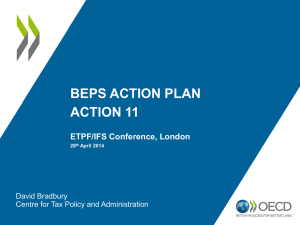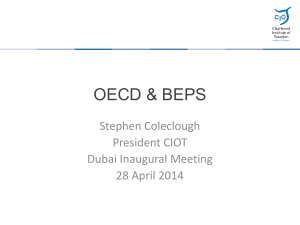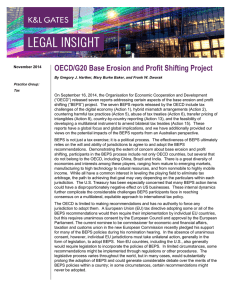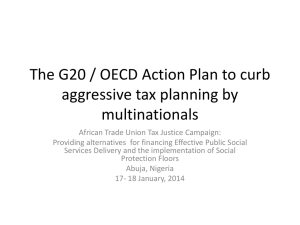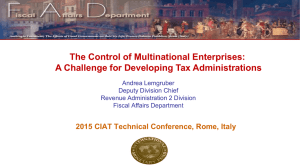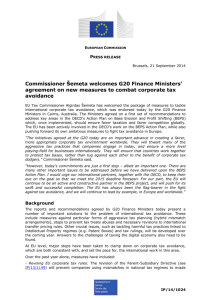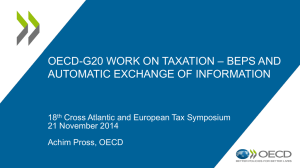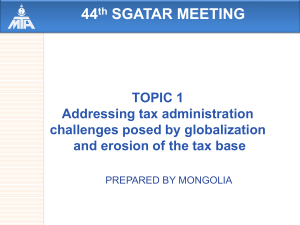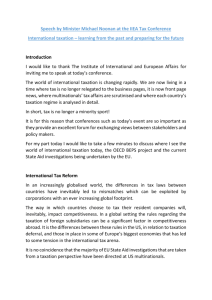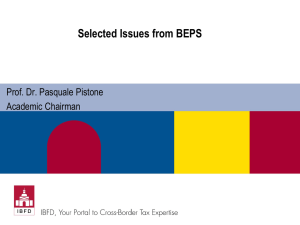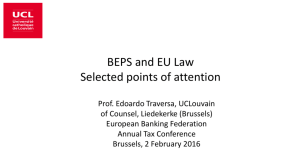03_Panel 1, Andrew Hickman, OECD
advertisement
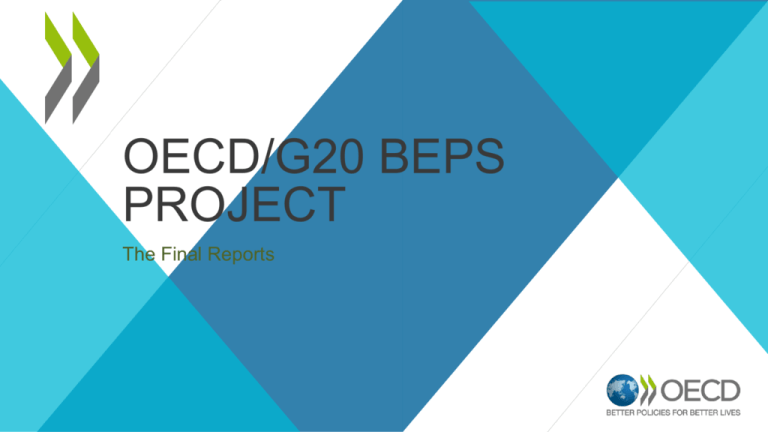
OECD/G20 BEPS PROJECT The Final Reports 1869 Globalisation 2 1869 2010 1890 1980 1920 2013 1950 Profit Base TaxErosion Base Shifting International Tax Rules 3 July 2013 October 2015 4 Coherence Substance Transparency Hybrid Mismatch Arrangements (2) Preventing Tax Treaty Abuse (6) Methodologies and Data Analysis (11) Interest Deductions (4) CFC Rules (3) Harmful Tax Practices (5) Avoidance of PE Status (7) TP Aspects of Intangibles (8) TP/Risk and Capital (9) TP/High Risk Transactions (10) Disclosure Rules (12) TP Documentation (13) Dispute Resolution (14) Digital Economy (1) Multilateral Instrument (15) Action Items 5 What’s in the BEPS package? Minimum standards Reinforced international standards on tax treaties and transfer pricing Common approaches and best practices for domestic law measures Analytical reports with recommendations (digital economy and multilateral instrument) Detailed report on measuring BEPS 6 International Consensus 7 Fiscal and economic effects Global annual CIT revenue Concentration of investments Net FDI to GDP ratios have increased sharply Loss of 4-10% (USD 100-240 bn) Better data is needed MNE effective tax rates 4% – 8.5% lower ETR than similar domestic firms % • To assess the effects of BEPS on shifting real economic activity • To perform statistical analysis based on Country-bycountry reports Key data on BEPS • To update periodic Corporate Tax Statistics 8 WHAT IS THE IMPACT ON BEPS? 9 Expected impact BEPS in a nutshell on BEPS HQ Ultimate Residence Country (High Tax) Parent Co • Ineffective/No CFC Rules • Maximise Deductions • Minimise Assets/Risks High Tax Intermediate Country Low Tax Intermediate Country Maximise Assets/Risks Market or Production Country (High Tax) Intermediate Co 2 • Avoid Taxable Presence or • Minimise Assets/Risks Intermediate Co 1 Local Activity • Hybrid Mismatch • Preferential Regime • Maximise Deductions Low or no Withholding tax Expected impact BEPS in a nutshell on BEPS • Ineffective/No ActionCFC 3 Rules Ultimate Residence Country (High Tax) Parent Co • Maximise Deductions Action 4 • Minimise Assets/Risks Action 8-10 High Tax Intermediate Country Low Tax Intermediate Country Maximise Action 8-10 Assets/Risks Market or Production Country (High Tax) Intermediate Co 2 • Avoid Taxable Action or 7 Presence • Minimise Action 8-10 Assets/Risks Intermediate Co 1 Local Activity • Hybrid Action 2 Mismatch • Preferential Action 5 Regime • Maximise Action 4 Deductions Low or no Withholding Action 6 tax Address techniques used totoavoid Limit Common interest approach deductibility: Nexus approach uses Address treaty abuse through a Align substance with value Include income creating the PE status, e.g. by replacing introduce Common coordination approach on tools. net minimum standards onin treaty creation expenditure through revised/new on R&D as aa BEPS concerns the distributor with a commissionnaire shopping (i.e. LOB and/or PPT) guidance for applying the ALP: interest Combination deductions of primary limited and to Proxy for Activity in IP definition of CFC income, e.g. arrangement; by artificially and anti-abuse clauses delineation ofregimes. actual transaction, defensive aother percentage rules. (between Ordering income from digital salesto fragmenting business activities risk10%-30%) allocation, intangibles rule that avoids of EBITDA double plus Compulsory take advantage ofspontaneous exceptions that including HTVI, CCA, taxation optional while group preventing wide ratio exchange of information on were initially adopted toand prevent commodity transactions double the taxation of non-taxation mere preparatory or rulings services Action 13 and/or by auxiliary activities; splitting-up construction contracts Exchange of rulings Country-by-Country Reporting FHTP MAC Membership Mandatory disclosure Transparency 12 Number of cases MAP cases initiated / completed by year 2500 2250 2000 1750 1500 1250 1000 750 2266 1910 1624 1599 1036 1176 1341 1311 1348 843 883 2006 2007 904 2008 1678 1571 1187 1146 2011 2012 1299 951 2009 2010 Year 2013 2014 Dispute Resolution 13 Minimum Standard + Peer review + Supplementary commitment Mandatory binding MAP arbitration A large group of countries >90% of MAP cases Dispute Resolution 14 New and revised rules Transparency Legal certainty and dispute resolution Monitoring Holistic Approach Q 15 WHAT’S NEXT? 16 G20 Leaders 16 November 2015 “We, therefore, strongly urge the timely implementation of the project and encourage all countries and jurisdictions, including developing ones, to participate. To monitor the implementation of the BEPS project globally, we call on the OECD to develop an inclusive framework by early 2016 with the involvement of interested non-G20 countries and jurisdictions which commit to implement the BEPS project, including developing economies, on an equal footing.” Inclusiveness Q 17 Website: www.oecd.org/tax/beps.htm Contact: CTP.BEPS@oecd.org Tax email alerts: www.oecd.org/ctp/tax-news.htm Via Twitter: Follow us via @OECDtax 18
